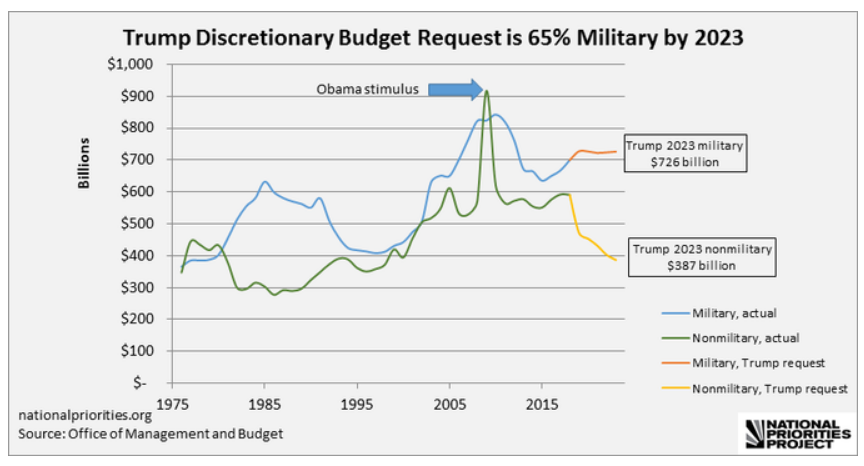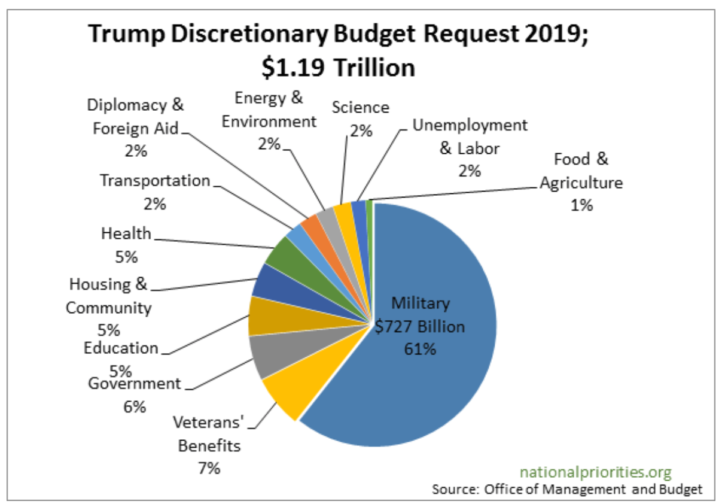
Republicans and Democrats like to claim that they are on opposite sides of important issues. Of course, depending on which way the wind blows, they sometimes change sides, like over support for free trade and federal deficits. Tragically, however, there is no division when it comes to militarism.
For example, the federal budget for fiscal year 2018 (which ends on September 30, 2018), included more money for the military than even President Trump requested. Trump had asked for a military budget of $603 billion, a sizeable $25 billion increase over fiscal year 2017 levels; Congress approved $629 billion. Trump had also asked for $65 billion to finance current war fighting, a bump of $5 billion; Congress approved $71 billion.
The National Defense Authorization Act of 2018, which set the target budget for the Department of Defense at this high level, was approved by the Senate in a September 2017 vote of 89-9.
In the words of the New York Times: “In a rare act of bipartisanship on Capitol Hill, the Senate passed a $700 billion defense policy bill…that sets forth a muscular vision of America as a global power, with a Pentagon budget that far exceeds what President Trump has asked for.”
That Act also called for a further increase in military spending of $16 billion for fiscal year 2019 (which begins October 1, 2018). And, in June 2018, the Senate voted 85 to 10 to authorize that increase, boosting the Defense Department’s fiscal year 2019 total to $716 billion.
This bipartisan embrace of militarism comes at enormous cost for working people. That cost includes cuts in funding for public housing, health care, and education; the rebuilding of our infrastructure; basic research and development; and efforts to mitigate climate change. It also includes the militarization of our police, since the military happily transfers its excess or outdated equipment to willing local police departments.
And it also includes a belligerent foreign policy. A case in point: Congress has made clear its opposition to the Trump administration decision to meet with North Korean leader Kim Jong-un and halt war games directed against North Korea, apparently preferring the possibility of a new Korean War. Congress is also trying to pass a law that will restrict the ability of the President to reduce the number of U.S. troops stationed in South Korea.
In brief, the U.S. military industrial complex, including the bipartisan consensus which helps to promote militarism’s popular legitimacy, is one of the most important and powerful foes we must overcome if we are to seriously tackle our ever-growing social, economic, and ecological problems.
The military is everywhere
The U.S. has approximately 800 formal military bases in 80 countries, with 135,000 soldiers stationed around the globe. Putting this in perspective, Alice Slater of the Nuclear Age Peace Foundation reports that:
“Only 11 other countries have bases in foreign countries, some 70 altogether. Russia has an estimated 26 to 40 in nine countries, mostly former Soviet Republics, as well as in Syria and Vietnam; the U.K., France, and Turkey have four to 10 bases each; and an estimated one to three foreign bases are occupied by India, China, Japan, South Korea, Germany, Italy, and the Netherlands.”
U.S. special forces are deployed in even more countries. According to Nick Turse, writing in The Nation, as of 2015, these forces were operating in 135 countries, an 80 percent increase over the previous five years. “That’s roughly 70 percent of the countries on the planet. Every day, in fact, America’s most elite troops are carrying out missions in 80 to 90 nations practicing night raids or sometimes conducting them for real, engaging in sniper training or sometimes actually gunning down enemies from afar.”
This widespread geographic deployment represents not only an aggressive projection of U.S. elite interests; it also provides a convenient rationale for those that want to keep the money flowing. The military, and those that support its funding, always complain that the military needs more funds to carry out its mission. Of course, the additional funds enable the military to expand the reach of its operations, thereby justifying another demand for yet more money.
Military spending is big for business
Almost half of the U.S. military budget goes to private military contractors. These military contracts are the lifeblood for many of the largest corporations in America. Lockheed Martin and Boeing rank one and two on the list of companies that get the most money from the government. In 2017, Lockheed Martin reported $51 billion in sales, with $35.2 billion coming from the government. Boeing got $26.5 billion. The next three in line are Raytheon, General Dynamics, and Northrop Grumman. These top five firms captured some $100 billion in Pentagon contracts in 2016.
And, as William Hartung, an expert on military spending, describes:
“The Pentagon buys more than just weapons. Health care companies like Humana ($3.6 billion), United Health Group ($2.9 billion), and Health Net ($2.6 billion) cash in as well, and they’re joined by, among others, pharmaceutical companies like McKesson ($2.7 billion) and universities deeply involved in military-industrial complex research like MIT ($1 billion) and Johns Hopkins ($902 million).”
Not surprisingly, given how lucrative these contracts are, private contractors work hard to ensure the generosity of Congress. In 2017, for example, 208 defense companies spent almost $100 million to deploy 728 reported lobbyists. Lobbying is made far easier by the fact that more than 80 percent of top Pentagon officials have worked for the defense industry at some point in their careers, and many will go back to work in the defense industry.
Then there are arms sales to foreign governments. A study by the Stockholm International Peace Research Institute that found that sales of weapons and military services by the world’s largest 100 corporate military suppliers totaled $375 billion in 2016, and making up 58 percent of international arms sales.
Eager to promote the arms industry, government officials work hard on their behalf. As Hartung explains: “From the president on his trips abroad to visit allied world leaders to the secretaries of state and defense to the staffs of U.S. embassies, American officials regularly act as salespeople for the arms firms.”
More for the military and less for everything else
The federal budget is divided into three categories: mandatory spending (primarily social security and Medicare), discretionary spending, and interest on the debt. Two trends in discretionary spending, the component of the budget set each year at the discretion of Congress, offer a window on how militarism is squeezing out funding for programs that serve majority needs.
The first noteworthy trend is the growing Congressional support for defense (base military budget) over non-defense programs. In 2001, the majority of discretionary funds went to non-defense programs, However, that soon changed, as we see in the chart below, thanks to the “war on terror.” In the decade following September 11, 2001, military spending increased by 50 percent, while spending on every other government program increased by only 13.5 percent.

In the 2018 federal budget, 54 percent of discretionary funds are allocated to the military (narrowly defined), $700 billion to the military and $591 billion to non-military programs. The chart below shows President Trump’s discretionary budgetary request for fiscal year 2019. As we can see, the share of funds for the military would rise to 61 percent of the total.
 In sum, Congress appears determined to squeeze non-defense programs, increasingly privileging defense over non-defense spending in the discretionary budget and allowing non-defense spending as a share of GDP to fall to record lows.
In sum, Congress appears determined to squeeze non-defense programs, increasingly privileging defense over non-defense spending in the discretionary budget and allowing non-defense spending as a share of GDP to fall to record lows.
The challenge ahead
Fighting militarism is not easy. Powerful political and business forces have made great strides in converting the United States into a society that celebrates violence, guns, and the military. Sadly, 39 percent of Americans polled support increasing our national defense while 46 percent think it is just about right. Only 13 percent think it is stronger than it needs to be.
Polls, of course, just reveal individual responses at a moment in time to questions that, in isolation, often provide respondents with no meaningful context or alternatives and thus reveal little about people’s true thoughts.
At the same time, results like this show just how important it is for us to work to create space for community conversations that are informed by accurate information on the extent and aims of U.S. militarism and its enormous political, social, economic, and ecological costs for the great majority of working people.
This is an abridged version of a longer article that originally appeared at Reports from the Economic Front. The full original can be read here.












Comments